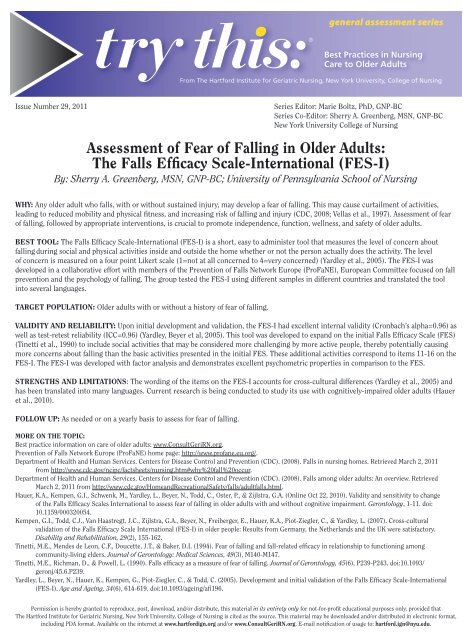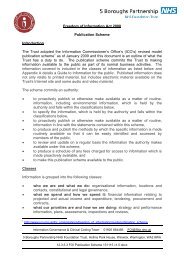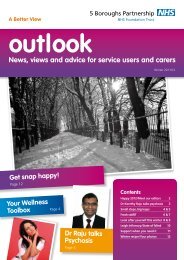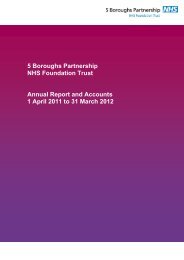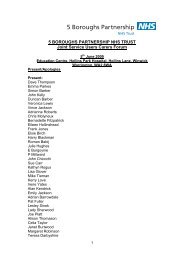The Falls Efficacy Scale-International (FES-I)
The Falls Efficacy Scale-International (FES-I)
The Falls Efficacy Scale-International (FES-I)
You also want an ePaper? Increase the reach of your titles
YUMPU automatically turns print PDFs into web optimized ePapers that Google loves.
general assessment series<br />
Best Practices in Nursing<br />
Care to Older Adults<br />
From <strong>The</strong> Hartford Institute for Geriatric Nursing, New York University, College of Nursing<br />
Issue Number 29, 2011<br />
Series Editor: Marie Boltz, PhD, GNP-BC<br />
Series Co-Editor: Sherry A. Greenberg, MSN, GNP-BC<br />
New York University College of Nursing<br />
Assessment of Fear of Falling in Older Adults:<br />
<strong>The</strong> <strong>Falls</strong> <strong>Efficacy</strong> <strong>Scale</strong>-<strong>International</strong> (<strong>FES</strong>-I)<br />
By: Sherry A. Greenberg, MSN, GNP-BC; University of Pennsylvania School of Nursing<br />
WHY: Any older adult who falls, with or without sustained injury, may develop a fear of falling. This may cause curtailment of activities,<br />
leading to reduced mobility and physical fitness, and increasing risk of falling and injury (CDC, 2008; Vellas et al., 1997). Assessment of fear<br />
of falling, followed by appropriate interventions, is crucial to promote independence, function, wellness, and safety of older adults.<br />
BEST TOOL: <strong>The</strong> <strong>Falls</strong> <strong>Efficacy</strong> <strong>Scale</strong>-<strong>International</strong> (<strong>FES</strong>-I) is a short, easy to administer tool that measures the level of concern about<br />
falling during social and physical activities inside and outside the home whether or not the person actually does the activity. <strong>The</strong> level<br />
of concern is measured on a four point Likert scale (1=not at all concerned to 4=very concerned) (Yardley et al., 2005). <strong>The</strong> <strong>FES</strong>-I was<br />
developed in a collaborative effort with members of the Prevention of <strong>Falls</strong> Network Europe (ProFaNE), European Committee focused on fall<br />
prevention and the psychology of falling. <strong>The</strong> group tested the <strong>FES</strong>-I using different samples in different countries and translated the tool<br />
into several languages.<br />
TARGET POPULATION: Older adults with or without a history of fear of falling.<br />
VALIDITY AND RELIABILITY: Upon initial development and validation, the <strong>FES</strong>-I had excellent internal validity (Cronbach’s alpha=0.96) as<br />
well as test-retest reliability (ICC=0.96) (Yardley, Beyer et al, 2005). This tool was developed to expand on the initial <strong>Falls</strong> <strong>Efficacy</strong> <strong>Scale</strong> (<strong>FES</strong>)<br />
(Tinetti et al., 1990) to include social activities that may be considered more challenging by more active people, thereby potentially causing<br />
more concerns about falling than the basic activities presented in the initial <strong>FES</strong>. <strong>The</strong>se additional activities correspond to items 11-16 on the<br />
<strong>FES</strong>-I. <strong>The</strong> <strong>FES</strong>-I was developed with factor analysis and demonstrates excellent psychometric properties in comparison to the <strong>FES</strong>.<br />
STRENGTHS AND LIMITATIONS: <strong>The</strong> wording of the items on the <strong>FES</strong>-I accounts for cross-cultural differences (Yardley et al., 2005) and<br />
has been translated into many languages. Current research is being conducted to study its use with cognitively-impaired older adults (Hauer<br />
et al., 2010).<br />
FOLLOW UP: As needed or on a yearly basis to assess for fear of falling.<br />
MORE ON THE TOPIC:<br />
Best practice information on care of older adults: www.ConsultGeriRN.org.<br />
Prevention of <strong>Falls</strong> Network Europe (ProFaNE) home page: http://www.profane.eu.org/.<br />
Department of Health and Human Services. Centers for Disease Control and Prevention (CDC). (2008). <strong>Falls</strong> in nursing homes. Retrieved March 2, 2011<br />
from http://www.cdc.gov/ncipc/factsheets/nursing.htm#why%20fall%20occur.<br />
Department of Health and Human Services. Centers for Disease Control and Prevention (CDC). (2008). <strong>Falls</strong> among older adults: An overview. Retrieved<br />
March 2, 2011 from http://www.cdc.gov/HomeandRecreationalSafety/falls/adultfalls.html.<br />
Hauer, K.A., Kempen, G.I., Schwenk, M., Yardley, L., Beyer, N., Todd, C., Oster, P., & Zijlstra, G.A. (Online Oct 22, 2010). Validity and sensitivity to change<br />
of the <strong>Falls</strong> <strong>Efficacy</strong> <strong>Scale</strong>s <strong>International</strong> to assess fear of falling in older adults with and without cognitive impairment. Gerontology, 1-11. doi:<br />
10.1159/000320054.<br />
Kempen, G.I., Todd, C.J., Van Haastregt, J.C., Zijlstra, G.A., Beyer, N., Freiberger, E., Hauer, K.A., Piot-Ziegler, C., & Yardley, L. (2007). Cross-cultural<br />
validation of the <strong>Falls</strong> <strong>Efficacy</strong> <strong>Scale</strong> <strong>International</strong> (<strong>FES</strong>-I) in older people: Results from Germany, the Netherlands and the UK were satisfactory.<br />
Disability and Rehabilitation, 29(2), 155-162.<br />
Tinetti, M.E., Mendes de Leon, C.F., Doucette, J.T., & Baker, D.I. (1994). Fear of falling and fall-related efficacy in relationship to functioning among<br />
community-living elders. Journal of Gerontology: Medical Sciences, 49(3), M140-M147.<br />
Tinetti, M.E., Richman, D., & Powell, L. (1990). <strong>Falls</strong> efficacy as a measure of fear of falling. Journal of Gerontology, 45(6), P239-P243. doi:10.1093/<br />
geronj/45.6.P239.<br />
Yardley, L., Beyer, N., Hauer, K., Kempen, G., Piot-Ziegler, C., & Todd, C. (2005). Development and initial validation of the <strong>Falls</strong> <strong>Efficacy</strong> <strong>Scale</strong>-<strong>International</strong><br />
(<strong>FES</strong>-I). Age and Ageing, 34(6), 614-619. doi:10.1093/ageing/afi196.<br />
Permission is hereby granted to reproduce, post, download, and/or distribute, this material in its entirety only for not-for-profit educational purposes only, provided that<br />
<strong>The</strong> Hartford Institute for Geriatric Nursing, New York University, College of Nursing is cited as the source. This material may be downloaded and/or distributed in electronic format,<br />
including PDA format. Available on the internet at www.hartfordign.org and/or www.ConsultGeriRN.org. E-mail notification of usage to: hartford.ign@nyu.edu.
<strong>Falls</strong> <strong>Efficacy</strong> <strong>Scale</strong>-<strong>International</strong> (English)<br />
I would like to ask some questions about how concerned you are about the possibility of falling. For each of the following activities, please<br />
circle the opinion closest to your own to show how concerned you are that you might fall if you did this activity. Please reply thinking about<br />
how you usually do the activity. If you currently don’t do the activity (example: if someone does your shopping for you), please answer to<br />
show whether you think you would be concerned about falling IF you did the activity.<br />
Not at all<br />
concerned<br />
1<br />
Somewhat<br />
concerned<br />
2<br />
Fairly<br />
concerned<br />
3<br />
Very<br />
concerned<br />
4<br />
1 Cleaning the house (e.g. sweep, vacuum, dust)<br />
2 Getting dressed or undressed<br />
3 Preparing simple meals<br />
4 Taking a bath or shower<br />
5 Going to the shop<br />
6 Getting in or out of a chair<br />
7 Going up or down stairs<br />
8 Walking around in the neighborhood<br />
9 Reaching for something above your head or on the ground<br />
10 Going to answer the telephone before it stops ringing<br />
11 Walking on a slippery surface (e.g. wet or icy)<br />
12 Visiting a friend or relative<br />
13 Walking in a place with crowds<br />
14<br />
Walking on an uneven surface (e.g. rocky ground, poorly<br />
maintained pavement)<br />
15 Walking up or down a slope<br />
16<br />
Going out to a social event (e.g. religious service, family<br />
gathering, or club meeting)<br />
Sub Total<br />
TOTAL /64<br />
Reprinted with permission from publisher.<br />
Reference: Yardley, L., Beyer, N., Hauer, K., Kempen, G., Piot-Ziegler, C., & Todd, C. (2005). Development and initial validation of the <strong>Falls</strong> <strong>Efficacy</strong> <strong>Scale</strong>-<br />
<strong>International</strong> (<strong>FES</strong>-I). Age and Ageing, 34(6), 614-619. doi:10.1093/ageing/afi196.<br />
Sherry Greenberg wishes to acknowledge that the development of this document was funded in part by a Ruth L. Kirschstein National Research Service Award<br />
(NRSA) Institutional Research Training Grant (T32) Individualized Care for At-Risk Older Adults, NewCourtland Center for Transitions and Health and the<br />
Center for Integrative Science in Aging, NIH/NINR (T32-NR009356) University of Pennsylvania School of Nursing.<br />
general assessment series<br />
Best Practices in Nursing<br />
Care to Older Adults<br />
A series provided by <strong>The</strong> Hartford Institute for Geriatric Nursing,<br />
New York University, College of Nursing<br />
EMAIL hartford.ign@nyu.edu HARTFORD INSTITUTE WEBSITE www.hartfordign.org<br />
CLINICAL NURSING WEBSITE www.ConsultGeriRN.org


